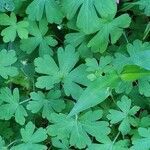Leaves 5-7-partite, (12-)20-30(-40) by (20-)25-50(-60) mm, the middle segment 3-lobed, lobes usually again with lateral lobules, free for (0.65-)0.75-0.85th part of its length, 1.8-7 mm wide at the base of its free part, obovate in outline, apex rounded to acuminate, apiculate, lateral and marginal nerves distinct, upper surface evenly moderately appressedly strigose, lower surface especially so on the nerves. Inflorescences 1-or 2-flowered. Peduncle in fruit 10-44(-67) mm long, pedicels then 9-16(-28) mm. Petals white (to pale red purple?), 3.5-6 mm long, 1-1.3 times as long as the 3.5-5 mm long sepals. Sepals in fruit 3.8-7.5 mm long.
A herb that keeps growing from year to year. It lies along the ground and has weak trailing stems. These can be 70 cm long. They are hairy. The leaves are almost round and 4.5-5.5 cm long by 4.5 cm wide. They have 3-5 lobes and these are divided into secondary lobes. The leaves are more pale underneath. They are hairy and have teeth along the edge. The flowers are in pairs and 8 mm across. The taproot is 4 cm long by 9 mm wide.

